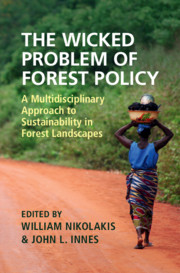 The Wicked Problem of Forest Policy
The Wicked Problem of Forest Policy A Decade of Implementation in the ‘Global South’
from Part I - Wicked Problems and Policies
Published online by Cambridge University Press: 24 July 2020
Payments for ecosystem or environmental services (PES) have become a popular biodiversity and forest conservation approach in the global South. Dozens of PES national programmes and hundreds of individual projects have been implemented across diverse geographies. This chapter reviews the evidence of a decade of PES implementation in the global South. This chapter examines how PES have delivered for the rural poor in these countries, looking specifically at any resulting impacts on local livelihoods and human wellbeing. Analyzing the benefits, costs and implications for the rural poor, this chapter shows that PES has to date delivered to the rural poor. Direct positive changes induced by PES include improvements in relative income and access to finance for public goods provision, the generation of a few jobs at a local level, gains in land management knowledge and skills, and the development of forest and biodiversity conservation activities, with relative low levels of labour input. Indirect effects include crowding-in, but at the same time increases in social conflict, negative environmental spill-overs, and rising inequality in access to income and resources. The social–ecological context where a PES programme is implemented is critical to the success of the programme.
To save this book to your Kindle, first ensure no-reply@cambridge.org is added to your Approved Personal Document E-mail List under your Personal Document Settings on the Manage Your Content and Devices page of your Amazon account. Then enter the ‘name’ part of your Kindle email address below. Find out more about saving to your Kindle.
Note you can select to save to either the @free.kindle.com or @kindle.com variations. ‘@free.kindle.com’ emails are free but can only be saved to your device when it is connected to wi-fi. ‘@kindle.com’ emails can be delivered even when you are not connected to wi-fi, but note that service fees apply.
Find out more about the Kindle Personal Document Service.
To save content items to your account, please confirm that you agree to abide by our usage policies. If this is the first time you use this feature, you will be asked to authorise Cambridge Core to connect with your account. Find out more about saving content to Dropbox.
To save content items to your account, please confirm that you agree to abide by our usage policies. If this is the first time you use this feature, you will be asked to authorise Cambridge Core to connect with your account. Find out more about saving content to Google Drive.